Closed corner divertor with B × ?B away from the divertor: a promising divertor scenario for tokamak power exhaust
Abstract
Keywords: divertor concept, closed divertor corner, E × B drifts, SOLPS-ITER simulation,EAST tokamak
1.Introduction
Controlling the heat flux onto the divertor target plates and the resulting material erosion is one of the most critical challenges that hinders the further development of fusion energy.Therefore, considerable effort has been made to develop innovative divertor solutions in the tokamak fusion community.There are generally two approaches for advanced divertor solutions [1-6].One approach is to use advanced poloidal magnetic configurations to widen the flux expansion and increase the connection length[1,2].The other approach is to develop optimized geometric structures to improve the divertor closure and trap neutrals and impurities to enhance dissipation and facilitate divertor detachment[3-5].Detached or partially detached divertor operations are desirable for a steady-state fusion reactor to avoid excessive heat deposition and material erosion at the divertor target plate.The dynamics of deuterium neutrals(molecules and atoms)and their spatial distribution in the divertor chamber of tokamaks are critical to achieve divertor detachment.A high divertor neutral pressure,which can be generally realized by increasing the divertor closure,is of great importance for particle and power exhausts[5].Several innovative divertors with closed geometric structures have been proposed,including the V-shape divertor for SlimCS [3], the SAS divertor developed in DIII-D [4, 5]and the recently installed right-angle closed divertor in EAST[6].The closed-divertor strategy aims at achieving divertor regimes with high dissipation and stable detachment over the entire divertor target at low levels of fueling, low upstream densities and impurity influx to meet the requirement of compatibility with high-performance steady-state core energy confinement scenarios in fusion reactors.
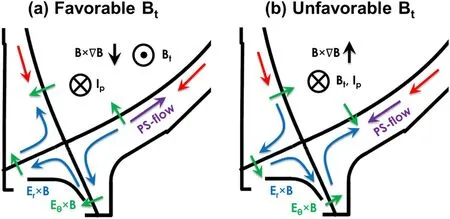
Figure 1.Schematic diagram of drifts in SOL and divertor regions for(a)B×?B towards the lower divertor,i.e.favorable Bt direction,and(b)B×?B away from the lower divertor,i.e.unfavorable Bt direction,with green arrows for Eθ×B drifts,blue arrows for Er×B drifts,purple arrows for Pfirsch-Schlüter flows and red arrows for parallel transport from the upstream SOL.The Pfirsch-Schlüter flow directs to lower divertor for upwards B × ?B, and changes its direction for downwards B × ?B.The Pfirsch-Schlüter flow is always in the same direction of the plasma current, thus it reverses poloidally with the change of Bt direction rather than Ip direction.
Influences of vertical and horizontal divertor target plates on the recycling neutrals were investigated earlier in ASDEX and JET [7] where corner pumps were applied.A general feature of vertical divertors is the accessibility to the partial detachment state: the plasma detaches mainly near the strike point,whereas in the far scrape-off layer(SOL)the plasma is still attached with rather high electron temperature Tet.For horizontal target plates with a pump duct at the SOL side,however,heat fluxes near the strike point are typically higher than those for vertical targets, since the recycled neutrals cannot be concentrated effectively to achieve cooling plasma conditions.
Upgrading of the previous lower graphite divertor to tungsten with a steady-state heat flux handling capacity of~10 MW m-2is a critical step to transition to a tokamak with full-metal plasma-facing components for EAST.One of the primary principles for designing the new tungsten divertor concept on EAST was devoted to develop and validate divertor schemes that have high dissipations and are fully detached at low upstream densities with low levels of impurity seeding, which are compatible with advanced longpulse H-mode core plasma scenarios [6].A new tungsten divertor was developed and installed recently in EAST,which features a right-angled divertor corner on the low field side that joins the horizontal and vertical divertor plates to enhance the retention of recycled neutrals, as shown in figure 1.The new EAST divertor has a more closed structure than the JET divertor where the pumping entrance is located in between the vertical and inclined slope target plates [8].Directions of plasma drifts are illustrated in figure 1 for cases with B×?B directed away from or towards the new lower divertor.The original idea of designing the new divertor is the corner effect,i.e.as the strike point locates at the horizontal plate, the recycling particles are reflected largely to the SOL, and then restricted by the vertical plate and thus trapped near the corner,so that Tein the SOL can be reduced significantly due to the build-up of high neutral pressure in the corner area.The principal contribution of this new manuscript is to study the differences between the favorable and unfavorable Btdirections and the impact of different strike point locations through SOLPS-ITER simulations, while only cases with a favorable Btdirection were investigated in [6].
The rest of this paper is organized as follows.In section 2, the principle of the closed corner divertor is introduced.In section 3, preliminary results from EAST discharges demonstrating the corner effect are presented.In section 4, the simulation results carried out with SOLPSITER simulations are shown.Summaries and discussions are presented in section 5.
2.Principle of the closed corner divertor
The ‘corner effect’ facilitates the local buildup of high neutral pressure near the corner, and thus strongly dissipative divertor regimes can be acquired so as to maintain stable detachment along the entire divertor target at relatively lower separatrix densities and impurity seeding rates,as required for compatibility with advanced core confinements.Specifically, when the outer strike point is located at the horizontal target, particularly near the corner, a large fraction of recycled neutrals is reflected towards the SOL.
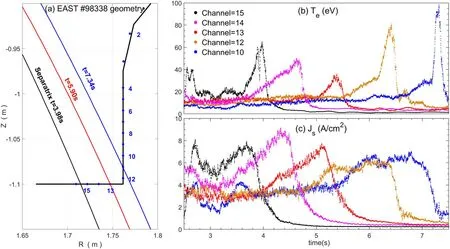
Figure 2.(a) Divertor Langmuir probes implemented in the lower diverter target at the low field side.The black, red and blue curves demonstrate the magnetic separatrices, magnetic reconstructed with EFIT, at three time slices (3.98 s, 5.90 s and 7.34 s), respectively.The blue points indicate the locations of divertor Langmuir probes.(b)Electron temperature and(c)ion saturation current measured with divertor Langmuir probes during the scanning of strike point from the horizontal towards the vertical target plate.
The vertical target plate will act as a baffle.These neutrals then become ionized and move along field lines back to the horizontal plate or are reflected by the vertical plate,increasing the effective dwelling time of neutrals and causing them to be trapped in the corner area.As a result, this trapping of recycling neutrals dramatically enhances divertor closure and reduces the number of recycled particles that can penetrate into the pedestal from the lower divertor.The leakage of neutrals into the PFR will be less compared to a vertical divertor geometry where the recycled neutrals will fly directly towards the PFR.In contrast, as the strike point locates on vertical target, the plate directs recycled neutrals towards the strike point and the private flux region (PFR)where the electron temperature and density are much lower than the SOL,so that they cannot be fully re-ionized and can fuel the pedestal from the PFR through the X-point area.Furthermore, the recycled neutral particles from the outer divertor target area are significantly more than that with the strike point on the horizontal target as there are more particles in the far SOL hitting the vertical plate.These neutral particles readily move across the separatrix, increasing the pedestal fueling [9].Therefore, the operation with strike point being on the horizontal target exhibits a much stronger capability of confining the recycling particles inside the divertor and reducing the pedestal fueling from the new divertor.The new divertor based on closed divertor concept in EAST provides a test bed for achieving steady-state detachment operations with high heating powers.The ‘corner effect’ is confirmed in preliminary experimental results and reasonable agreement with SOLPS-ITER simulations including drift effects is obtained.
3.Experimental measurements
The recently installed lower tungsten divertor in EAST was operated successfully during the recent experimental campaign (May-July, 2021) including discharges with injected heating power as high as 7.5 MW.A series of dedicated divertor shots have been carried out, such as long-pulse detachment feedback control discharges and high-power discharges to validate the design idea of this tungsten divertor and investigate the divertor plasma physics involved.
For instance, during the L-mode discharge #98338 [6],the strike point position of outer divertor was scanned slowly to the vertical target from the horizontal target plate as indicated in figure 2(a),where three typical positions of the outer strike point at three different time slices are shown.The corresponding equilibria are calculated by magnetic reconstruction with EFIT.At t = 3.98, 5.90 and 7.34 s, the outer strike point was situated far from and close to the corner at the horizontal target plate,and close to the bottom of the vertical target plate, respectively.The main operation parameters in this discharge are Ip≈ 500.0 kA, Bt≈ 2.5 T, nel≈2.1×1019m-3, WMHD≈115.0 kJ, and q95≈6.3 under double null (DN) magnetic configuration with upwards ion B×?B drift,where nel,WMHDand q95denote line-averaged plasma density, stored energy and edge safety factor,respectively.The corresponding triangularity reduces gradually from 0.63 to 0.5 as the outer strike point scans from horizontal to vertical target plates.The heating power is 2.3 MW in total, which includes 0.5 MW LHW at 2.45 GHz,1.4 MW LHW at 4.6 GHz and 0.4 MW ECW.No extrinsic impurity was injected in this shot.

Figure 3.Computational meshes in modeling(quadrangles in sky blue for plasmas,extended triangles in lavender for neutrals)for magnetic configurations at(a)3.98 s,(b)5.90 s,and(c)7.34 s of the EAST shot#98338.D+flows are estimated at interfaces numbered with S1-S5.
The divertor closure can be influenced by the distance between the corner and the strike point.Figure 2(b)illustrates Teevolution at the divertor target measured with divertor Langmuir probes 10-15.The peak Teis situated in the SOL region near the strike point.The maximum Tedecreases as the strike point approaches the corner along the horizontal target plate.The lowest maximum Teis obtained as the strike point locates in the vicinity of the corner on the horizontal plate(measured by probe 13).The highest maximum Teis measured as the strike point locates at the vertical plate.Therefore, the corner effect is clearly evidenced by this experimental result.
In the following section, SOLPS-ITER simulations including drift effects are performed using the three different divertor plasma configurations corresponding to t = 3.98,5.90 and 7.34 s.Both upward and downward B × ?B drift directions are modeled to gain more insight into the geometric effects and drift effects.
4.Modeling results by using SOLPS-ITER
4.1.Basic setups in simulations
The meshes used in SOLPS-ITER simulation corresponding to t=3.98,5.90 and 7.34 s are illustrated in figures 3(a)-(c)and are termed as horizontal, near-corner and vertical cases,respectively.In the modeling, only deuterium speciesis included.Both upward and downward ion B × ?B drifts are considered for each configuration, and thus 6 cases in total are modelled.Fixed ionic deuterium density at core-edge interface (CEI) is applied and its value is adjusted to acquire similar electron density at the upstream separatrix,neu≈1.0×1019m-3,for upward and downward B × ?B directions to make reasonable comparisons with respect to the divertor plasma states.D2puffing is switched off and at CEI boundary the D+flux is self-adjusted to obtain the preset density.The radiated power loss by intrinsic impurities is about 0.8 MW in the core region for this discharge,and thus the total power that enters CEI is set as 1.5 MW.The power is partitioned equally between ions and electrons.
Cross-field drifts,especially E×B drift,would generally influence the divertor asymmetry through generating significant convective particle flux [10].However, it is worth noting that incorporating full drifts and currents into SOLPSITER modeling requires the use of a smaller time step and can be challenging, especially for cases with ion B × ?B drift pointed away from the X-point, to converge due to the associated numerical instabilities.Here,drifts and currents are fully activated except for the fraction accounting for the E×B drift which is set as 0.6.Recycling coefficients at first wall and divertor target plates are assumed as 1.0.The ratios for released thermal D2molecules and reflected fast D atoms due to the wall recycling are calculated with the plasmasurface interaction model included in the SOLPS-ITER package [11].Leakage boundary conditions are applied at PFR and SOL boundaries.Sheath conditions for ion and electron temperatures,as well as for ion densities are set at the target plate boundary.The radial heat conductivity and particle diffusivity are set as constant,χi=χe=1.2 m2s-1,Dn=0.5 m2s-1.The resultant near-SOL λqis 6.0-8.2 mm with these transport coefficients.The experimental λqvalue varies in the range of 3-8 mm when scanning the strike point positions,which is slightly smaller than the simulated λq.Due to incomplete activation of drifts in the simulations, we did not precisely match the simulated profiles with the measured profiles in the experiments.However, this small discrepancy does not affect the main physical conclusions of the work.
4.2.Simulation results
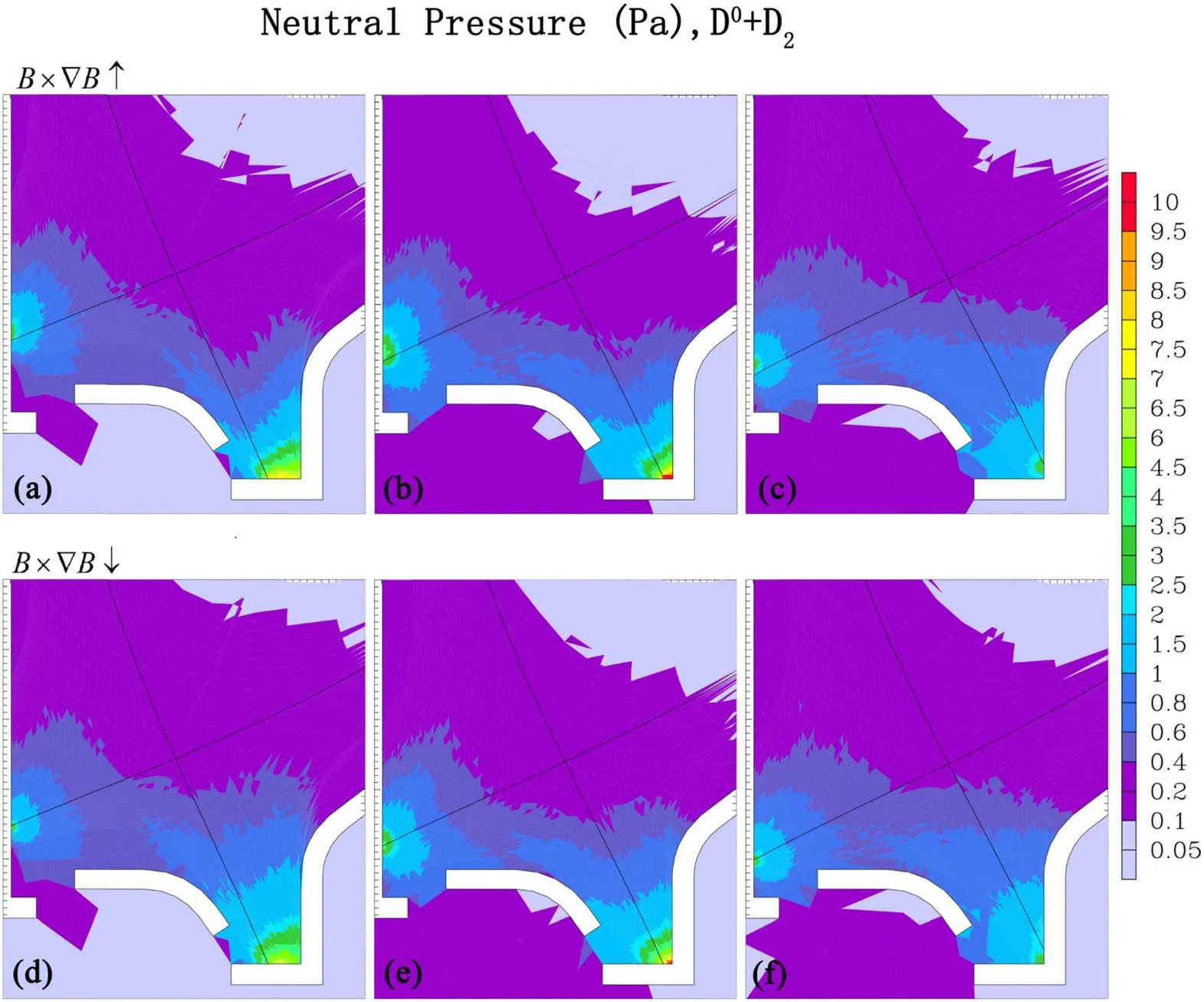
Figure 4.The simulated 2D patterns of the neutral pressure contributed by deuterium atoms and molecules in ((a), (d))horizontal, ((b), (e))near-corner and((c),(f))vertical cases.The subfigures in the first row correspond to simulations with upwards B×?B while the results with downwards B × ?B are shown in the second row.

Table 1.D+flux that passes across the five interfaces indicated in figure 3.For S1,S3 and S5,the flux is driven by poloidal E×B drift.For S2 and S4, the flux is resulted from radial E×B drift.The unit is 1020 s-1.
Convective flow due to classic drifts is dominated by E×B drift in the divertor region.Therefore, we firstly calculate the D+flux generated by E×B drift at five interfaces, S1-S5as shown in figure 3, to evaluate its contribution to particle exchange between inner and outer divertor regions.S1and S5are selected at the inner and outer divertor entrances,respectively.S2and S4are along the divertor legs.S3separates the inner PFR and outer PFR.According to SOLPSITER conventions, positive directions are poloidally clockwise towards the outer divertor from the inner divertor, and radially outwards to SOL edge from the core.The fluxes through the interfaces, which are contributed by E×B drift,are summarized in table 1.For example, in the Horizontal case with downwards B×?B,the poloidal D+flux entering the outer divertor through S5is 1.26×1021s-1and that leaving the inner divertor through S1is 1.11×1021s-1.The poloidal D+flux through S3, -1.83×1021s-1,indicates the transferring of ionic deuterium to the inner divertor from the outer divertor, acting as a particle sink at the outer divertor and a particle source at the inner divertor.Table 1 demonstrates that this situation applies also to the near-corner and vertical cases with downwards B×?B.As a result,the inner divertor becomes denser and colder while the outer divertor has a reduced density and increased temperature in configurations with downwards B × ?B.As the direction of magnetic field is reversed(upwards B×?B),the drift fluxes at the interfaces change sign which makes the inner divertor a particle source and the outer divertor a particle sink,facilitating outer divertor detachment.The contribution from the Pfirsch-Schlüter flow is relatively smaller compared to the E×B drift (not shown in the table).
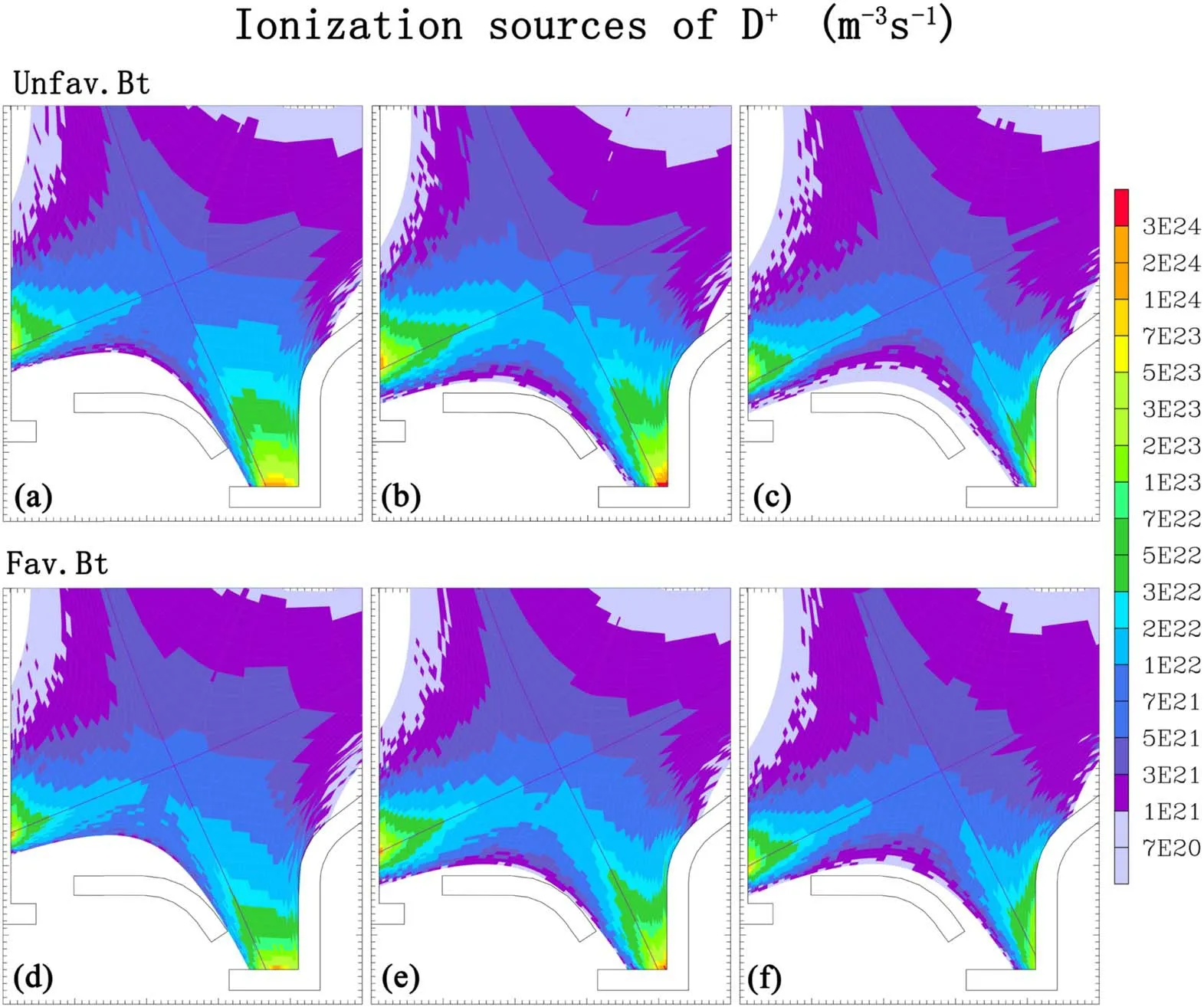
Figure 5.The simulated 2D patterns of the ionization source for D+in((a),(d))horizontal,((b),(e))near-corner and((c),(f))vertical cases.The subfigures in the first row correspond to simulations with upwards B×?B while the results with downwards B×?B are shown in the second row.
In tokamaks, neutrals are produced mostly from plasma ions through recycling at plasma-facing components.These neutral particles re-ionize and charge-exchange with plasma ions,which disperse heat and momentum.The plasma state in divertor relates strongly to the neutral density and pressure near the target plate [12-14].The combination of the geometric effects of the new EAST divertor and the drift effects with B×?B pointed away from the divertor generates a promising divertor scenario to facilitate detachment and heat flux mitigation by making use of the recycling neutrals.Patterns of the neutral pressure distribution(including deuterium molecules and atoms) at the same upstream electron densityneu≈1.0×1019m-3for the six cases are demonstrated in figure 4.For horizontal target plate cases in figures 4(a) and(d), the divertor corner locates on the SOL side and a neutral cushion is formed in the area between the corner and the outer strike point.As a result,the electron temperature Teis reduced as will be shown later.The maximum neutral pressure is about 9.3 Pa for upwards B× ?B and 7.2 Pa for downwards B × ?B.When the strike point moves closer to the corner,the maximum neutral pressure increases to as high as 11.5 Pa as indicated in figure 4(b) with upwards B × ?B.By changing the Btdirection, although the closure of corner is weakened with downwards B×?B,the peak value still exceeds 10.0 Pa,as seen in figure 4(e),due to the geometric effects.As the outer strike point moves further onto the vertical divertor plate, the recycled neutrals are directed towards the strike point and the PFR where the corner is situated.As some of the particles are lost to PFR, the resulting neutral pressure as shown in figure 4(c)is maximized close to the strike point but with a maximum of only~5.0 Pa, much smaller than the Horizontal or the near-corner case.
The distribution of ionization particle source for the 6 cases is illustrated in figure 5.When the strike point is located on the horizontal plate,recycled neutrals are reflected towards the SOL region, creating an ionization region in front of the outer target plate between the closed corner and the strike point.This ionization region provides access to plasma conditions with high density and low temperature, which can facilitate approaching detachment.As the strike point approaches to the corner, the ionization intensity increases,especially with upwards B×?B in figure 5(b).As the strike point is situated on the vertical target,the ionization intensity is much lower in the vicinity of the strike point compared with the strike point on the horizontal target plate.
As the inner strike point moves towards the slant reflector plate from the vertical plate, influences of the corner on neutral concentrations were also indicated in the simulations of ITER divertor [15] leading to an enhanced detachment degree and mitigations of the heat load.
The primary philosophy of the conventional vertical divertor target is to re-ionize the recycled neutrals in the vicinity of the strike point to efficiently reduce the electron temperature Teand heat flux qtthere, such as the ITER-like divertor.However, the impinging particles are largely reflected as neutrals towards the PFR by the vertical target,and most of the particles cannot return to the SOL.As a result, it is difficult to concentrate the recycled neutrals towards the SOL which typically leads to relatively lower neutral density and pressure and higher Tein the far-SOL.While for the horizontal divertor especially with a closed corner, incoming particles are largely directed towards the SOL region where most of them are ionized or reflected back again by the vertical plate.Therefore, particles are trapped within the SOL region near the corner, facilitating achievement of high neutral pressure with enhanced dissipation and reduced Te.If the closed corner is replaced with a pumping duct, such as the outer divertor of JET [16], the divertor closure will be greatly relaxed.For example, simulation results during the conceptual design stage of the new EAST divertor demonstrate that high neutral pressures will almost disappear as the pumping duct is positioned at the lower end of the vertical plate [17].

Figure 6.The simulated profiles ofalong the outer target plates for horizontal(black square),near-corner(red dot),and vertical(blue star)cases with B×?B directed upwards(left)and downwards(right).The position of the outer strike point is indicated by the dashed black line.
In figure 6,the spatial profiles of ne,Te,j‖,outand qtalong the outer divertor target are plotted.For upwards B×?B,the maximum electron density in the near-corner case is about 1.5 times larger than the horizontal case and 3 times higher than the vertical case.Correspondingly, the near-corner case has the lowest electron temperature and the largest particle flux,while the vertical case has the highest electron temperature and the lowest particle flux.The simulated Teandj‖,outare in reasonable agreement with the measurements as shown in figure 2(b).The discrepancy between the simulations and experiments could be ascribed to the incomplete activation of drift effects and the uncertainties in radial transport coefficients.The heat flux in the vertical case is lower due to several factors, including a relatively low particle flux, a misalignment between the maximum particle flux and the maximum electron temperature,and a more grazing incidence angle of field lines in the vertical case.For downwards B×?B,the outer diverter acts as a particle source while the inner divertor as a particle sink, resulting in the reduction of plasma density and the increase of Tein the outer SOL as shown in figures 6(e)-(h).
5.Summary and discussions
For the divertor in future steady-state tokamak fusion reactors, not only exhausts of particle and power but also controlling of tungsten impurity source is critical to obtain stationary high-performance operations [18].To keep the tungsten sputtering erosion and tungsten concentration in the core plasma at an acceptable level, it is required to achieve a divertor target temperature of Tet< 5 eV and density net>1021m-3[19].Although the typical vertical-target divertor,for instance the ITER divertor, has the advantages of relatively smaller field-line incident angle, lower heat flux in the vicinity of strike point and better particle exhaust capability,however it has the disadvantage of too high target electron temperature Tetin the far SOL, typically much larger than 10 eV, which is unacceptable for tungsten impurity sputtering.The resulting erosion rate is not serious for today’s devices, but will be unacceptable for future fusion reactors[19, 20].The high Tetis mainly because the vertical target is unfavorable for the concentration of particles in the SOL.To solve this problem,we proposed the concept of closed corner divertor [6] and the divertor operational scenario which combines the ‘corner effect’ and the effect of E×B drifts with B × ?B away from the divertor.As indicated in the SOLPS-ITER simulation, as the outer strike point locates on the horizontal target, the target plate will reflect a significant number of recycled neutrals into the SOL where they are re-ionized and move along field lines back to and recycle again at the horizontal plate or are reflected again by the vertical plate.Thus, these particles are trapped within the corner area, dramatically enhancing the divertor closure and reducing the number of recycled particles that can penetrate into the pedestal from the divertor.As a result of the concentration of recycling particles in the SOL, the temperature at the outer target Tetis effectively reduced, as demonstrated by the EAST experiments in figure 2.The present work does not cover the conditions of detachment either in modeling or in experiment aspects.However, radiated power loss due to impurities can be used to achieve detachment.The required levels of impurity seeding for different cases (such as those with varying strike point locations and Btdirections) may differ and depend on the characteristics of the background divertor plasma.To elaborate further, the effectiveness of impurity seeding for achieving detachment may depend on the properties of the divertor plasma.In particular, a divertor plasma with high density/neutral pressure and low temperature (near-corner case with an unfavorable Btdirection) can facilitate high power exhaust,which in turn might necessitate lower levels of impurity seeding.Therefore, the near-corner case with an unfavorable Btdirection is likely to satisfy the compatibility requirement between a detached divertor and a high-performance core.
Furthermore, we notice that this divertor scenario has a significantly larger particle flux along the entire horizontal plate compared with the conventional vertical target scenario,as indicated in figure 6(c), mainly due to the much higher density, indicating that this divertor scenario may have a stronger particle exhaust capability, which is extremely important for fusion reactors to remove the helium ash.
The E×B drifts play critical roles in enhancing the outer divertor density and particle flux.With B×?B away from the divertor, the E×B drifts in the divertor move particles from the inner divertor to the outer divertor and the Pfirsch-Schlüter flows move particles from the upstream towards the outer divertor(the former dominates over the latter), as indicated in figure 1, which significantly increase the particle flux and density in the outer divertor.This effect has been demonstrated by the EAST experiments.A relatively lower Tetand higher jsare always observed for B×?B away from the divertor under the same parameter conditions.As a result, the detachment density threshold is much lower and the detachment is more easily accessible with B × ?B away from the divertor in comparison with B × ?B pointed to the divertor [21].
The SAS divertor in DIII-D [4] is a highly closed divertor, and exhibits advantages in improving neutral trapping and facilitations of divertor plasma detachment.As compared with the SAS divertor in DIII-D,the EAST‘closed corner’divertor design is more conductive for actively watercooled W/Cu plasma-facing components, provides great engineering reliability, and does not require precise control over the strike point location, which can be challenging to achieve in EAST.The divertor scenario proposed here may potentially provide a promising divertor solution for steadystate operations of future tokamak fusion reactors with much higher power fluxes.However, the power threshold for L-H transition is usually higher with B × ?B away from the divertor, which is a major unfavorable factor.Partly for this reason,ITER is designed to operate with downwards B×?B direction.In addition, a relatively lower H98factor is usually obtained with B × ?B directed away from the divertor compared with B × ?B towards the divertor [22], but impurity exhaust capability is usually stronger,which is more important for steady-state high-performance operations in a tokamak with full-metal plasma-facing components.As the controlling of heat flux and impurity concentration are more serious challenges for future fusion reactors,they should have higher priorities than other factors,thus this divertor scenario may be a solution that deserves serious considerations.
Acknowledgments
This work was funded by the National Magnetic Confinement Fusion Program of China (Nos.2019YFE03030000,2019YFE03080500 and 2022YFE03060004), National Natural Science Foundation of China (No.U19A20113).
ORCID iDs
Lingyi MENG (孟令義)https://orcid.org/0000-0002-8633-5383
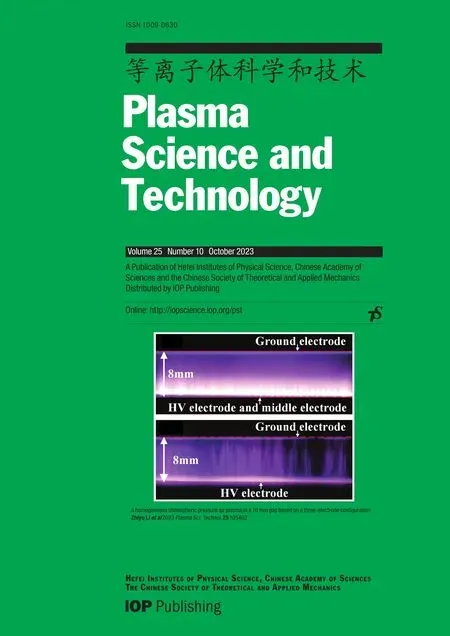 Plasma Science and Technology2023年10期
Plasma Science and Technology2023年10期
- Plasma Science and Technology的其它文章
- 3D fluid model analysis on the generation of negative hydrogen ions for negative ion source of NBI
- Enhancing surface adhesion of polytetrafluoroethylene induced by two-step in-situ treatment with radiofrequency capacitively coupled Ar/Ar+CH4+NH3 plasma
- Etching characteristics and surface modification of InGaSnO thin films under Cl2/Ar plasma
- Pulsed gas-liquid discharge plasma catalytic degradation of bisphenol A over graphene/CdS: process parameters optimization and O3 activation mechanism analysis
- A homogeneous atmospheric pressure air plasma in a 10mm gap based on a threeelectrode configuration
- Effect of gas flow on the nanoparticles transport in dusty acetylene plasmas
